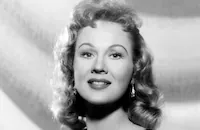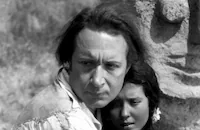Flaxy Martin

Brief Synopsis
Cast & Crew
Richard Bare
Virginia Mayo
Zachary Scott
Dorothy Malone
Tom D'andrea
Helen Westcott
Film Details
Technical Specs

Synopsis
After Caesar, one of gangster Hap Richie's henchmen, commits a murder, Hap orders his lawyer, Walter Colby, to obtain Caesar's release from jail. Tired of defending criminals, Walt wants to leave Hap's organization, and to prevent this, Hap recruits singer Flaxy Martin, with whom Walt is in love. Flaxy convinces Walt to wait until they have saved more money before quitting his job, and he agrees to work for Caesar's release. Behind Walt's back, Flaxy and Hap pay Peggy Ferrar to say that she was with Caesar the night of the murder, and he is released for lack of evidence. The plan backfires, however, when Peggy tries to blackmail Hap, saying that she will admit to perjury unless he pays her $10,000. Hap then orders Caesar to kill Peggy and implicate Flaxy. When Flaxy, who is in on Hap's plan, goes to Walt for help, he confesses to having killed Peggy in self-defense in order to protect Flaxy. At his trial, however, a cabdriver claims to have witnessed Walt murdering Peggy. The district attorney is suspicious of the cabbie's story and tries to convince Walt to tell the truth, but Walt maintains his silence and is convicted. Garage owner Sam Malko, who owes Walt a favor, later visits him in prison and reveals that Caesar has been bragging that Walt is taking a rap for him. Determined to clear himself, Walt escapes from a train while he is being moved to another prison. He flags down passing motorist Nora Carson, who drives him home and bandages the wounds he sustained in his escape. Learning Walt's identity, Nora offers to help him, but he does not want to involve her. Before he can leave, however, the police arrive, alerted by a nosy neighbor. At the same time, Roper, one of Hap's men, comes in the back door. He locks the police in the closet, and after handcuffing Nora and Walt together, takes them away. They struggle with their captors and escape, still cuffed together. Heading for New York, they use a ruse to pass the roadblock and drive to Sam's garage for help. Leaving Nora at the garage, Walt then goes to Caesar's apartment, where Roper is waiting for him after having killed Caesar. Walt manages to get away, but Roper follows and tries to kill him. During the ensuing struggle, Roper is killed when he falls off the roof. Walt then confronts Flaxy, who claims that she framed him to save his life. When Hap later arrives at her apartment, she pulls a gun on both men and steals Hap's wallet. There is a struggle and in the confusion, Flaxy shoots Hap. Walt turns Flaxy in for Hap's murder and returns to Sam's garage and Nora. When Nora refuses to run away with Walt, however, he turns himself in, and Nora promises to wait for his release.

Director

Richard Bare
Cast

Virginia Mayo

Zachary Scott

Dorothy Malone

Tom D'andrea

Helen Westcott

Douglas Kennedy

Elisha Cook Jr.

Douglas Fowley

Monte Blue
Jack Overman
Jack Cheatham
George Sherwood
Rudy Robles
Rory Mallinson
Eddie Hart
Charles Sherlock
Buddy Roosevelt

Harlan Warde
John Harmon

Lee Phelps
Philo Mccullough

Marjorie Bennett
Charles Mcavoy
Billy Mclean
John Elliott

Jack Mower
Bob Stephenson
Max Wagner
Ed Dearing
Eddie Parker
Louis Hicks
Paul Bryar
Frances Morris
Crew
Alma Armstrong
George Bau
Everett A. Brown
Herschel Brown
Elmer Decker
Edwin Dupar
Saul Elkins
Carl Guthrie
Stuart Higgs
Lou Jennings
Victor Johnson
Mac Julian
David Lang
William Lava
Rydo Loshak
Frank Magee
Charles Maxwell
John Maxwell
William Mcgann
James Mcmahon
Don Page
Pat Patterson
Lyle B. Reifsnider
Irva Mae Ross
Ted Smith
Doris Stutz
Claude Swanner
Red Turner
Perc Westmore

Videos
Trailer
Hosted Intro
Film Details
Technical Specs

Articles
Virginia Mayo (1920-2005)
She was born Virginia Clara Jones in St. Louis, Missouri on November 30, 1920, and got her show business start at the age of six by enrolling in her aunt's School of Dramatic Expression. While still in her teens, she joined the nightclub circuit, and after paying her dues for a few years traveling across the country, she eventually caught the eye of movie mogul Samuel Goldwyn. He gave her a small role in her first film, starring future husband, Michael O'Shea, in Jack London (1943). She then received minor billing as a "Goldwyn Girl," in the Danny Kaye farce, Up In Arms (1944). Almost immediately, Goldwyn saw her natural movement, comfort and ease in front of the camera, and in just her fourth film, she landed a plumb lead opposite Bob Hope in The Princess and the Pirate (1944). She proved a hit with moviegoers, and her next two films would be with her most frequent leading man, Danny Kaye: Wonder Man (1945), and The Kid from Brooklyn (1946). Both films were big hits, and the chemistry between Mayo and Kaye - the classy, reserved blonde beauty clashing with the hyperactive clown - was surprisingly successful.
Mayo did make a brief break from light comedy, and gave a good performance as Dana Andrews' unfaithful wife, Marie, in the popular post-war drama, The Best Years of Their Lives (1946); but despite the good reviews, she was back with Kaye in The Secret Life of Walter Mitty (1947), and A Song Is Born (1948).
It wasn't until the following year that Mayo got the chance to sink her teeth into a meaty role. That film, White Heat (1949), and her role, as Cody Jarrett's (James Cagney) sluttish, conniving wife, Verna, is memorable for the sheer ruthlessness of her performance. Remember, it was Verna who shot Cody¿s mother in the back, and yet when Cody confronts her after he escapes from prison to exact revenge for her death, Verna effectively places the blame on Big Ed (Steve Cochran):
Verna: I can't tell you Cody!
Cody: Tell me!
Verna: Ed...he shot her in the back!!!
Critics and fans purred over the newfound versatility, yet strangely, she never found a part as juicy as Verna again. Her next film, with Cagney, The West Point Story (1950), was a pleasant enough musical; but her role as Lady Wellesley in Captain Horatio Hornblower R.N. (1951), co-starring Gregory Peck, was merely decorative; that of a burlesque queen attempting to earn a university degree in the gormless comedy, She¿s Working Her Way Through College (1952); and worst of all, the Biblical bomb, The Silver Chalice (1954) which was, incidentally, Paul Newman's film debut, and is a film he still derides as the worst of his career.
Realizing that her future in movies was slowing down, she turned to the supper club circuit in the 60s with her husband, Michael O'Shea, touring the country in such productions as No, No Nanette, Barefoot in the Park, Hello Dolly, and Butterflies Are Free. Like most performers who had outdistanced their glory days with the film industry, Mayo turned to television for the next two decades, appearing in such shows as Night Gallery, Police Story, Murder She Wrote, and Remington Steele. She even earned a recurring role in the short-lived NBC soap opera, Santa Barbara (1984-85), playing an aging hoofer named "Peaches DeLight." Mayo was married to O'Shea from 1947 until his death in 1973. She is survived by their daughter, Mary Johnston; and three grandsons.
by Michael T. Toole

Virginia Mayo (1920-2005)
Quotes
Trivia
Notes
The film's working title was Smart Money.
















